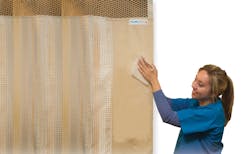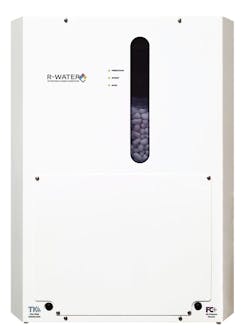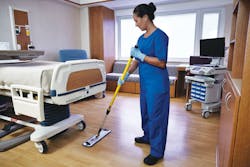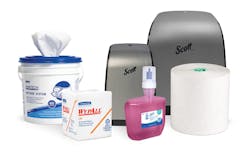EVS blends mix of cleaning practices for hospital disinfection
Every day, environmental services (EVS) departments play an instrumental role on the front lines keeping hospital and healthcare facilities, patients, visitors and staff protected from infectious pathogens. EVS workers conduct routine cleaning and disinfection of surfaces in rooms as directed by industry guidelines and standards. Pandemic health crises, like COVID-19, however, may call for orchestrating additional measures of cleaning and decontamination in these settings.
Increasing volume and enhancement of cleaning
During COVID-19, some EVS teams, such as at UAB Medicine in Birmingham, AL, have expanded their cleaning repertoire, supplies and schedules to ensure the safest possible healthcare environments.
“UAB Medicine has always followed strict guidelines for cleaning our hospitals and clinics, and we are doing even more during the COVID-19 outbreak. To help prevent the spread of the virus, our Environmental Services staff use special cleaning products and procedures and wear masks, gloves, face shields or goggles, and gowns. They clean and sanitize more often than usual and in more places, paying special attention to ‘high-touch’ surfaces such as handrails, door handles, elevator buttons, and restrooms,” reported UAB Medicine.
The EVS team added significant time and focus cleaning areas where patients with COVID-19 received care. “A standard terminal clean after a patient is discharged or moved to another area takes 35-40 minutes. For rooms that were occupied by a patient with COVID-19, EVS team members must wait an hour after the patient has left before starting to clean. They wear full personal protective equipment and follow “enhanced contact precautions,” which call for a double cleaning that takes up to 65 minutes using a disinfectant called Oxivir Tb. A double cleaning includes a normal full cleaning, followed by a second full cleaning and more attention to frequently touched surfaces. Privacy curtains are changed, the walls are cleaned, and the room is sprayed with a hydrogen peroxide-based disinfectant mist that clings to surfaces.”
Representatives from cleaning and disinfectant manufacturers as well as infection prevention and clinical education specialists share with Healthcare Purchasing News the latest EVS cleaning supplies, equipment and techniques used to help keep hospitals adequately cleaned, sanitized and safe for care.
All things touched
Everyone who visits, works in or is cared for in a hospital comes in contact with many objects and spaces prone to contamination.
“There are tens of thousands of high-touch areas in a hospital,” pointed out John Mazzaccaro, Vice President of Sales, HAIGuard. “Your exposure starts in a lobby with its furniture or in a wheelchair at the ER, depending on how you arrive. Once inside, there are tens of thousands of pieces of portable equipment moved around by staff from room to room and shared by patients. There are semi-permanent fixtures like cubicle curtains, shades and shower curtains that collect and share pathogens as staff make rounds and patients come and go. Every surface your patients, visitors and staff can reach will be touched and pathogens will be shared.”
Rayne Guest, Founder and CEO, R-Water LLC, calls out various items that are brought in, are placed down and can transmit pathogens.
“Personal items such as purses and bags, cell phones, laptops, or magazines and books shouldn’t be overlooked,” Guest said. “Visitors constantly bring in items for their loved ones, including takeout from restaurants. A kind gesture of retrieving or moving a personal item for a patient or resident can easily spread pathogens. Shoes bring in a ton of germs. All it takes is picking up one piece of luggage or purse from the floor and sitting it on a patient’s bed to dramatically increase the risk of infections.”
Intensive care, OR and patient rooms are some of the highest-touched areas, addresses Marc-Oliver Wright, MT(ASCP), MS, CIC, FAPIC, Clinical Science Liaison , PDI Healthcare.
“Researchers have found an average of 44 objects are touched in ICUs per encounter, while 13 surfaces are touched in general patient care rooms,” Wright said. Objects closer to the patient, like bed rails, supply carts and IV pumps, are touched more frequently and are considered ‘high touch surfaces.’ In operating rooms a similar study found that high-touch surfaces include the computer mouse, OR bed, door and medication cart, with many of these surfaces being contaminated even after the rooms are terminally cleaned. Waiting rooms, bathrooms and other areas have not been studied as well, but it would not be surprising that high-use objects—toilet flush handles, sink handles, light switches, door knobs and arm chairs—would be the most frequently touched.”
Areas touched less often also pose contamination risks, explains Doe Kley, Senior Infection Preventionist, Clorox Healthcare.
“It’s important, however, to keep in mind that touch contamination can occur from any item or surface, not just the high-touch ones,” Kley noted. “A 2015 study by Cheng et al found an average of 93 contacts with surfaces per hour in healthcare settings. Furthermore, a single medical device can consist of up to 40 different materials. So, it is critical that surface compatibility with your disinfectants is a consideration.”
Brian Le, Synexis, adds, “One study found that a healthcare worker’s hands are as likely to be contaminated by touching an environmental surface as they are by direct contact with a patient.”
Good hand hygiene, stresses Martin McGonagle, SC Johnson Professional, is another essential part of preventing the spread of contaminants.
“Hands are a key touchpoint for transmitting microorganisms to those surfaces, which is why special attention should be paid to hand hygiene protocol,” McGonagle said. “It’s important to clean and disinfect surfaces, but it’s also critical to maintain a diligent and frequent hand hygiene protocol for staff, patients and visitors.”
Kristen Venegas, Sr. Customer Experience Manager, Kimberly-Clark Professional, agrees that hand hygiene, when done in the correct manner, leads to safer disinfection and care.
“We talk about ‘hot spots’ a lot at KCP,” Venegas stated. We have many studies that show high germ counts on these frequently touched surfaces and how easily these germs can be transmitted from person to person. Did you know, 95 percent of people do not wash their hands long enough? It is good to remember that proper hand washing and drying with a paper towel (which removes 77 percent of bacteria on hands) is not only critical for hospital staff, but also for patients and visitors in preventing the spread of germs.”
Trusted standards and effects of cleaning
During pandemics, or any time of care, what guides EVS in their cleaning and disinfection processes?
“It’s standard practice to align protocols with CDC and AHE guidelines. Proper cleaning method (e.g. ‘clean to dirty’ or ‘high to low’) is key, because, as the CDC states, “the actual physical removal of microorganisms and soil by wiping or scrubbing is probably as important, if not more so, than any antimicrobial effect of the cleaning agent used,” indicated Michelle Olsen, Senior Category Manager – Cleaning, Rubbermaid Commercial Products. “The equipment and area closest to the patient — the ‘hot zone’ — is going to be the most contaminated. Starting with the cleanest areas will prevent spreading pathogens from heavily contaminated areas into cleaner areas. Products like our HYGEN microfiber cloths and mop pads are designed to provide optimal cleaning and remove 99.9 percent of tested virus and bacteria to help prepare surfaces for disinfection. We’ve developed products like our Flexi-Frame and Flex-Wand for use with HYGEN microfiber, so that you can clean all surfaces, top-to-bottom, corner-to-corner. An often-forgotten contaminated surface is a waste receptacle lid, which is why we’ve eliminated that surface with our Step-On Container.”
The Association for the Health Care Environment (AHE) emphasizes the efficacy of its cleaning guidance for EVS during COVID-19. They note, however, that extra cleaning time may be needed during the pandemic.
“The guidelines and processes we have already established for EVS are sufficient for COVID-19 cleaning. Although you may want to increase frequency of cleaning and disinfecting of high-touch surfaces. If a patient was coughing and remained in the room for a long period of time or underwent an aerosol-generating procedure, allow sufficient time for airborne contaminant removal before performing a discharge clean,” stated AHE.
Some facilities are turning to technology to help manage EVS cleaning in accordance with new guidelines during COVID-19, addressed Venegas, of Kimberly-Clark Professional.
“While the CDC has been sharing a lot of new and heightened COVID-19-specific protocols for cleaning and disinfecting, some hospitals are beginning to adopt IoT to improve efficiencies,” Venegas said. “Predictive data from connective devices has shown improved cleaning metrics along with a shift in focus from towel, tissue and skincare dispensers to more critical needs like deep cleaning and disinfecting.”
SC Johnson Professional’s McGonagle recommends EVS and infection control have a say in the cleaning and disinfecting practices developed for facilities. This should include a concentration on high-touch areas and adherence to manufacturers’ instructions for use (IFU).
“It’s important that facilities follow the collective input from infection control and Environmental Services (EVS) personnel. This will help them make an educated decision to establish their own protocols and cleaning regimens based on this information,” McGonagle expressed. “Certain high-touch surfaces need to be cleaned more frequently, and in some cases, after every contact. Special attention should be paid to high-touch surfaces within high-traffic areas, such as waiting rooms and lobbies. It’s important to follow label instructions when disinfecting surfaces. Labels specify contact times needed for proper disinfection. For example, SC Johnson Professional’s Coverage Plus Germicidal Surface Wipes offer a two-minute contact time and is broad spectrum against microorganisms. If the disinfectant is wiped away before two minutes have passed, the effectiveness of the product will decrease.”
What do standard EVS cleaning and disinfection methods look like in a hospital setting?
Wright, of PDI Healthcare, points to terminal and daily cleaning in OR and patient rooms.
“In general, procedure areas are cleaned and disinfected after each procedure, with an emphasis on high-touch surfaces and any surfaces or equipment that may come in contact with the patient,” Wright explained. “At the end of the day, these rooms undergo a terminal clean, where additional surfaces, such as the floor outside of the immediate procedure area or air vents, are disinfected. In patient rooms, there is daily cleaning of surfaces, including high-touch objects, counters and the patient’s bathroom, and a terminal clean upon discharge where equipment is removed and all surfaces, including those not easily accessed during occupancy, are cleaned/disinfected. EVS staff are using disinfectants with an emerging viral pathogen claim approved by the EPA – these are also known as List N disinfectants.
“While no disinfectant yet has been proven to kill SARS-CoV-2, the ones included on this list are effective at killing viruses similar to or stronger than the coronavirus. Many are using supplemental disinfection, such as UV light, as an additional measure in hopes of reducing the risk of transmission.”
Patient rooms undergo daily and discharge cleaning, notes R-Water LLC’s Guest.
“Orkin VitalClean disinfection service efforts are focused on healthcare common areas such as waiting rooms, nursing stations and offices,” Black stated. “The number of high-touch surfaces might surprise you. Our pest management professionals are trained observers. They apply that same keen observation when figuring out what high-touch and low-touch areas may exist in an area and need to be treated. We use lint-free cloths to apply a first round of disinfectant, a process that also helps dislodge pathogens. Then we follow up with a mist application of the disinfectant. The mist is created by a specific application tip that allows for a specific particle size of droplet. The mist allows for an even treatment that will hold wet for 10 minutes.”
Still, even when patients with COVID-19 are treated in a hospital, many standards of cleaning still apply, expresses Deborah Chung, healthcare marketing manager, Essity North America.
“With some exceptions, cleaning and disinfections of areas that were exposed to COVID-19 do not differ greatly from routine procedures,” Chung noted. “In addition to routine procedures, EVS staff should be disinfecting high-touch surfaces more frequently than usual. CDC recommends using alcohol-based hand rubs with greater than 60 percent ethanol or 70 percent isopropanol in health care settings to help prevent the spread of COVID-19.”
Meaning and impact of deep cleaning
Depending on who you ask, deep cleaning holds different meanings within and outside of healthcare environments.
“Deep cleaning is often associated with a shutdown resulting from exposure to pathogen or a protocol preceding reopening of a shuttered facility,” indicated Matt Schiering, Contec, Inc. “Prior to COVID-19, one would have heard this term most frequently in reference to a cruise ship, nursing home or school that had endured a norovirus outbreak. Deep cleaning is often simply treating high-touch surfaces to ensure confidence prior to allowing people to expose themselves to these same surfaces upon reopening. Everything from UV and fogging devices to ‘old school’ scrubbing brushes and high-level disinfectants each have their place in addressing COVID-19 concerns. It may seem trite, but mechanical removal and adherence to label dwell times remains a tried and true way to ensure efficacious and efficient elimination of pathogens.”‑
Synexis’ Le draws a connection between deep cleaning, terminal cleaning and complementary cleaning practices.
“In healthcare, deep cleaning is often associated with terminal cleaning,” Le said. “Deep cleaning is the ability to thoroughly clean and disinfect the room, top to bottom, at a single point in time, but the minute an individual enters that room, the process of recontamination begins. It would be advantageous if you could augment deep cleaning by employing measures, such as dry hydrogen peroxide (DHP), that continuously and comprehensively keep microbial levels down. Synexis’ automated technology produces DHP from ambient oxygen and humidity and is safe for occupied settings. DHP permeates a space from ceiling to floor, corner to corner, addressing every surface – low, medium and high-touch. Increased quality and frequency of cleaning and disinfection are key strategies in preventing COVID-19 spread.”
Deep cleaning involves more time and areas of cleaning, according to Kley, of Clorox Healthcare.
“Deep cleaning should not be confused with terminal cleaning,” explained Kley. “While a terminal clean is more extensive than an occupied room cleaning, deep cleaning is even more extensive than terminal cleaning. Deep cleaning happens on a routine schedule depending on the traffic. It entails cleaning everything, including curtains, walls, ceilings and hard-to-reach areas. Floors are typically stripped and deep cleaned. Scheduling deep cleaning means coordinating with department managers as it may entail closing a unit or parts of a unit.”
Still, Linda Homan, RN, BSN, CIC, Senior Manager Clinical Affairs, Ecolab Healthcare, views the standard methods of cleaning as appropriate for any circumstances.
“During this pandemic, as with any other time, hospital surfaces are contaminated with pathogens and we want to ensure that all contaminated surfaces are properly cleaned and disinfected,” Homan stated. “The term ‘deep cleaning’ has been used to convey the message that cleaning is done more thoroughly than usual. In truth, the routine cleaning and disinfection practices already in place for hospital environmental hygiene are designed to protect staff and patients and have been proven to remove harmful bacteria and viruses from surfaces when done thoroughly and consistently. The term ‘deep cleaning’ is not meaningful or recommended when performing environmental hygiene during the COVID-19 pandemic. Rather than recommending a different level or type of cleaning, the CDC recommends ensuring that routine environmental cleaning and disinfection procedures are followed consistently and correctly.”
HAIGuard’s John Mazzaccaro, however, sees a growing need for deep cleaning during COVID-19.
“At HAIGuard, we define deep cleaning as a next-level disinfection process,” Mazzaccaro shared. “The ability to clean and disinfect what we can’t see and can’t reach can only be achieved by using innovative technology, finding more manpower and implementing next-level protocols on both a set schedule and an emergent basis. Staff, visitors and patients will need to be assured that where they go in a healthcare setting and what they touch is safer than ever before because the stakes are higher.
“COVID-19 has made us more aware of the things that we can’t see and how they can directly hurt us. This market response and cultural change is creating a demand for services like our Hydrogen Peroxide Vaporization process in order to reach new standards and restore lost confidence. HAIGuard’s process can thoroughly disinfect previously unreached places where microbes can hide and grow.”
As the focus on deep cleaning has increased and the availability of cleaning supplies has decreased, some EVS teams have shifted to alternative products, notes Kimberly-Clark Professional’s Venegas.
“Going back to those ‘hot spots’, deep cleaning is ensuring that nothing has been overlooked and that cleaning and disinfecting products are being used properly according to their instructions and guidelines. With skyrocketing demand, a lot of cleaning and disinfecting products have been extremely difficult to get. EVS staff have been more willing to try new solutions that differ from what they have traditionally used. At KCP we have seen a lot of demand for our WetTask Disposable Wiping System. Unlike traditional pre-sats, this system gives EVS staff the ability to add the cleaning chemicals of their choice while also providing cost-in-use benefits of switching from pre-sats.”
Deep cleaning may also help meet the needs of special situations, explains Wright, of PDI Healthcare.
“The term ‘deep cleaning’ is to enhance the current practice with superior products or practices in the context of a specific problem or need,” Wright addressed. “For example, an EVS department at a long-term care facility might use a standard low or intermediate level disinfectant for routine cleaning of rooms. But if a resident has a gastrointestinal illness, EVS might switch to a sporicidal disinfectant, like bleach, and increase the frequency of cleaning. Deep cleaning can also include what is called “supplemental disinfection,” where after a room is manually cleaned/disinfected, the room undergoes an additional—and often hands-free—disinfection cycle using advanced technology like ultraviolet light to kill any germs left behind after manual cleaning.”
Rooms where patients with COVID-19 have been treated require additional cleaning time and PPE, points out Kley, of Clorox Healthcare.
“After discharge of a COVID-19 patient, the CDC states EVS staff should delay entry into the room for terminal cleaning until sufficient time has elapsed for air exchanges to remove infectious particles,” Kley said. “The minimum PPE that should be worn to enter the room for terminal cleaning are gown and gloves. Wear a mask if the facility is practicing universal masking. Other PPE such as eye protection should be added if splash or spraying during cleaning and disinfection activities are anticipated or are otherwise required based on the products in use. Additionally, the CDC recommends using products with EPA-approved emerging viral pathogens claims against SARS-CoV-2.
“Clorox Healthcare has several ready-to-use disinfecting products with the EPA-approved emerging viral pathogen claim, including Bleach Germicidal Wipes, Fuzion Cleaner Disinfectant, Hydrogen Peroxide Wipes as well as Clorox Healthcare’s newly launched Spore Defense Cleaner Disinfectant. This is the first sporicidal solution available through the Clorox Total 360 electrostatic system and qualifies for use against SARS-Cov-2.”
No matter when, how or where they are cleaning, EVS rises to the occasion to safely clean and disinfect areas for the safety of all, stresses R-Water LLC’s Guest.
“I believe all cleanings should be deep cleanings, especially ‘Discharges,’ Guest stated. “The only way to achieve that level of proper disinfection is to strictly adhere to contact times and protocols. EVS has one of the toughest and most important jobs in any hospital or extended care facility working tirelessly to create the safest possible environment for patients, residents, nurses, doctors, other staff members and visitors.”
EVS Product Listings & Spotlights
Endnotes
- Behind the Scenes: How UAB Keeps You Safe During COVID-19, https://www.uabmedicine.org/-/how-uab-keeps-the-hospital-clean-during-covid-19
- Huslage K, et al. Infect Control Hosp Epidemiol. 2010 Aug;31(8):850-3
- Link T, et al. Am J Infect Control 2016 Nov 1;44(11):1350-1355
- The AHE Resource: COVID-19 EVS Considerations, https://www.ahe.org/system/files/media/file/2020/04/EVS_Considerations_Infographic.pdf
- EPA, Pesticide Registration, List N: Disinfectants for Use Against SARS-CoV-2, https://www.epa.gov/pesticide-registration/list-n-disinfectants-use-against-sars-cov-2
- CDC, Coronavirus Disease 2019 (COVID-19), Healthcare Infection Prevention and Control FAQs for COVID-19, https://www.cdc.gov/coronavirus/2019-ncov/hcp/infection-control-faq.html?CDC_AA_refVal=https percent3A percent2F percent2Fwww.cdc.gov percent2Fcoronavirus percent2F2019-ncov percent2Finfection-control percent2Finfection-prevention-control-faq.html
- CDC, Infection Control, Appendix B. Air Guidelines for Environmental Infection Control in Health-Care Facilities (2003), https://www.cdc.gov/infectioncontrol/guidelines/environmental/appendix/air.html#tableb1

Ebony Smith
Ebony Smith was previously Managing Editor for Healthcare Purchasing News.












